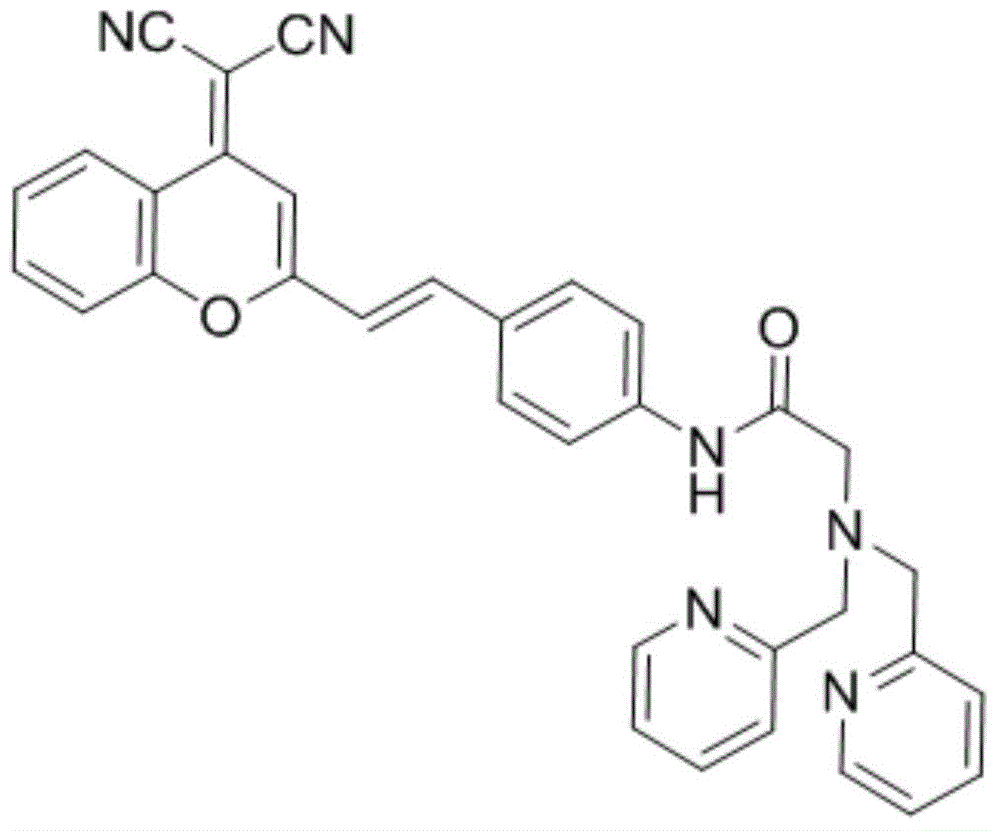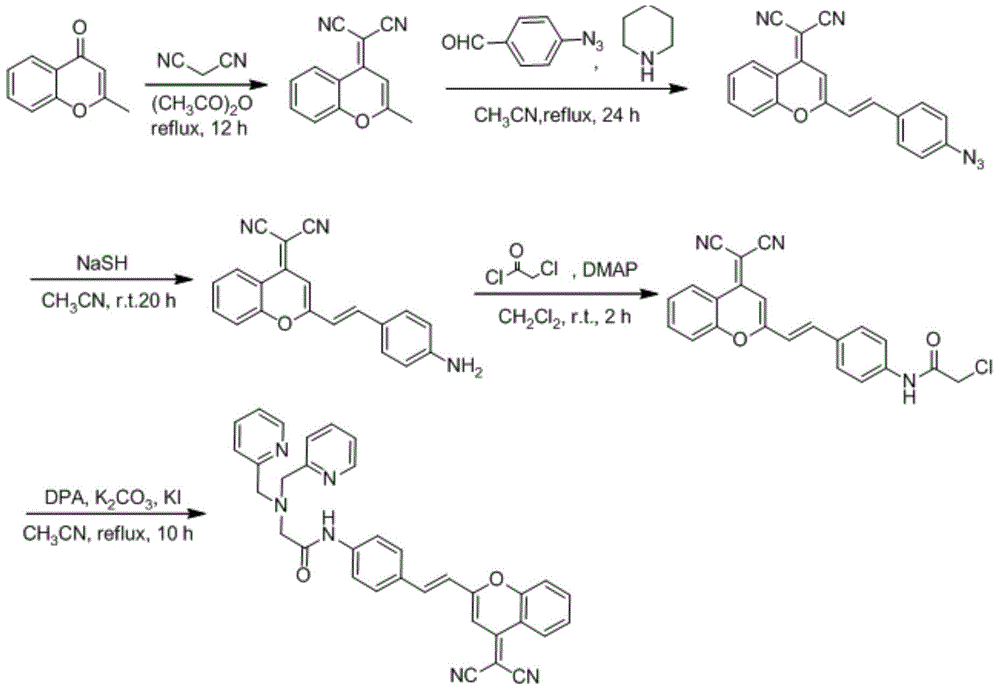Ratio-type variant receptor mercury ion fluorescent probe and its preparation method and use
A fluorescent probe, mercury ion technology, used in fluorescence/phosphorescence, chemical instruments and methods, luminescent materials, etc., can solve problems such as interference and poor binding selectivity of mercury ions, and achieve simple and convenient post-processing, mild reaction conditions, and identification. Ability-Specific Effects
- Summary
- Abstract
- Description
- Claims
- Application Information
AI Technical Summary
Problems solved by technology
Method used
Image
Examples
Embodiment 1
[0026] Embodiment 1: the preparation of the fluorescent probe of variant acceptor ratio type mercury ion, the basic synthesis process is as follows:
[0027] Synthesis of benzopyranonitrile: Add benzopyrone (2g, 12.5mmol) to a 100mL single-necked bottle, then add 40mL of acetic anhydride, then add malononitrile (1g, 15.15mmol), reflux and stir for 12 hours, rotate Evaporate acetic anhydride, add 30 mL of deionized water and reflux reaction for half an hour, filter to obtain a filter cake and recrystallize with absolute ethanol to obtain 0.35 g of a yellow solid. The yield of benzopyranonitrile was 14%. The hydrogen spectrum data of benzopyranonitrile are as follows: 1 H NMR (CDCl 3 ,500MHz)δ8.92(d,J=9Hz1H),7.72(t,J=7.5Hz,1H),7.46(d,J=8Hz,2H),6.72(s,1H),2.44(s,3H) .
[0028] Synthesis of 4-azidostyrylbenzopyranonitrile: under argon protection, add 4-azidobenzaldehyde (155mg, 0.75mmol) and benzopyranonitrile (110mg, 0.75mmol) into a 25mL flask, add Freshly distilled acetoni...
Embodiment 3
[0034] Embodiment 3: The response situation of fluorescent probe to mercury ion determination
[0035] Figure 4-Figure 8 All the data in this paper are tested in a mixed solution of DMF and HEPES (pH=7.4) (volume ratio 5:5), and the excitation wavelength is 459nm.
[0036] Figure 4 When the concentration of the probe is 10 μm, when the concentration of mercury ions is 0, 2, 4, 6, 8, 10, 15, 20, 30 μm, the fluorescence spectrum is obviously red-shifted and enhanced, and the red-shift is 83nm. 8 times. It shows that the modification has occurred after combining with mercury ions.
Embodiment 4
[0037] Embodiment 4: the selectivity of fluorescent probe to mercury ion determination
[0038] Add 10μm probe molecules under the same reaction conditions, and then add other metal ions, such as: Ag + ,Al 3+ , Ba 2+ , Ca 2+ ,Cd 2+ ,Co 2+ ,Cr 3+ ,Cu 2+ ,Fe 2+ ,Fe 3+ ,K + ,Mg 2+ ,Mn 2+ , Na + , Ni 2+ ,Pb 2+ ,Pd 2+ ,Pt 2+ ,Rb + ,Sr 2+ ,Zn 2+ , with a concentration of 30 μm. The result is as Figure 5 with Image 6 , only the mercury ions had obvious red shift enhancement changes, and other metal ions did not change too much. Therefore, the probe still has good selectivity and sensitivity to mercury ions in the presence of the above-mentioned interference ions. Embodiment 5: the complexation ratio of fluorescent probe and mercury ion
PUM
 Login to View More
Login to View More Abstract
Description
Claims
Application Information
 Login to View More
Login to View More - R&D
- Intellectual Property
- Life Sciences
- Materials
- Tech Scout
- Unparalleled Data Quality
- Higher Quality Content
- 60% Fewer Hallucinations
Browse by: Latest US Patents, China's latest patents, Technical Efficacy Thesaurus, Application Domain, Technology Topic, Popular Technical Reports.
© 2025 PatSnap. All rights reserved.Legal|Privacy policy|Modern Slavery Act Transparency Statement|Sitemap|About US| Contact US: help@patsnap.com



